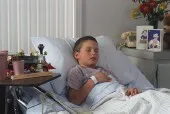Better funding is vital to improve treatments, experts say
WebMD News from HealthDay

By Amy Norton
HealthDay Reporter
THURSDAY, Nov. 7 (HealthDay News) -- Recent decades have seen huge strides in treating childhood cancer, but certain types of tumors remain difficult to treat and are often deadly.
That's the frustrating fact at the heart of a meeting held this week by the American Association for Cancer Research. Pediatric cancer experts gathered in San Diego to discuss recent advances in understanding childhood tumors and the obstacles to improving kids' care.
"The exciting thing is that we're in an era of unprecedented discovery," said Dr. John Maris, referring to recent research on the genetic underpinnings of childhood cancers. "But there's still a huge amount of work to be done."
One of the challenges in pediatric cancer research is that, thankfully, it's relatively rare for children to develop cancer, said Maris, who directs the Center for Childhood Cancer Research at Children's Hospital of Philadelphia.
In the United States, one or two out of every 10,000 kids develop cancer each year, according to the U.S. National Cancer Institute. It amounts to around 12,000 cases of childhood cancer and about 1,500 deaths annually.
Dr. James Downing, deputy director of St. Jude Children's Research Hospital in Memphis, Tenn., said that's a very small amount compared with the number of adults diagnosed with cancer.
As a result, Downing said, government funds and drug companies' interests are largely focused on adult cancer.
"There are also very important practical considerations, because these are children," Maris said.
Drugs of any kind typically are tested first in adults to help shield kids from toxic effects of experimental therapies. Safety concerns, plus limited resources and other issues, can slow progress.
"In pediatrics, we have to be very, very careful about prioritizing what we test," Maris said.
In some cancer areas, there have been huge success stories. A major example is the blood cancer acute lymphoblastic leukemia (ALL), the most common type of cancer in children. In the early 1960s, only about 4 percent of U.S. children diagnosed with ALL were alive five years later. Now that number exceeds 90 percent.
Overall, the five-year survival rate from all childhood cancers combined has risen from around 60 percent in the mid-1970s to more than 80 percent in more recent years, according to the cancer institute.
Downing said, however, that cancer still kills more kids under age 15 than any other disease. And certain types remain stubbornly resistant to everything doctors have thrown at them.
"There's a subset of cancers where we just have not made progress," Maris said.
One example is a tumor of the brain stem called pontine glioma -- a "terrible disease," Downing said, that usually kills within a year.
Another example is neuroblastoma, a cancer of the nerve tissue in various parts of the body that usually arises before age 5. Many more kids survive the disease than in years past, but the chances depend in part on the child's age.
source : Despite Major Progress, Some Childhood Cancers Are Still Killers








